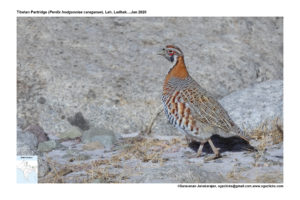
Tibetan Partridge Perdix hodgsoniae
Etymology:
- Perdix : Latin word for Partridge
- Hodgsoniae: Named after Anne Hodgson (d. 1868) wife of English naturalist Brian Houghton Hodgson
Distribution in India: Resident in North Himalayas.
Description: Size of 28–31 cm; wt. of 294–450 g. It has a very distinctive head and neck pattern. The forehead, supercilia, chin, central throat and partial neckband are white, lores are streaked black, ear-coverts and throat-sides are black, band on forecrown and crown-sides are chestnut. The nape and neck-sides are chestnut, while rest of underparts is white, heavily scaled black. It has chestnut on breast-sides and lower fore flanks, rest of flanks boldly barred chestnut with fine pale shaft-streaks, with large blackish patch on central lower breast and upper belly, and rest of underparts are dull whitish. The upperparts and wings are dull grey-brown, finely barred darker with whitish-buff shaft-streaks, but flight feathers are darker brown, barred and mottled buff, and scapulars and wing-coverts are barred rufous-brown. The tail is chestnut, except central feathers. The female is slightly smaller and duller than male. Iris is brown to reddish brown, bill is pale greenish horn, facial skin is red in breeding male) and legs are greyish horn. The juvenile is duller and largely featureless, with no chestnut or greyish in plumage; the crown and ear-coverts are dark brown with white tips to feathers, underparts are brownish buff, with weak vermiculations and pale shaft-streaks. The races found in India are , Nominate (Arunachal Pradesh), race caraganae (Ladhak and Uttarakhand) is paler and greyer than nominate, with narrower, brighter rufous-buff collar on nape and broader buff shaft-streaks on scapulars and wing-coverts.
Habitat: It is found in dry hillsides with scattered dwarf junipers, bushes, and near cover such as crops, grass or brush. It is found in summer above 3600 m up to 5600 m.
Food Habits: It eats seeds and insects; sometimes feeds in close proximity to yak herders for the insects the yaks dig out by their movement.
Breeding Habits: They breed in April-Aug in India. They are monogamous. The nest isa scrape in the ground, lined with grass, sited under cover. They lay a clutch of 8-10 pale eggs ,laid at 1–2-day intervals. The incubation period is 20–24 days, commenced with last egg done by female alone. The male assists in looking after the chicks. They form crèches amongst themselves to look after the chicks.